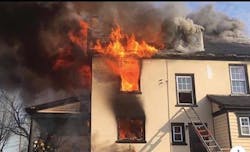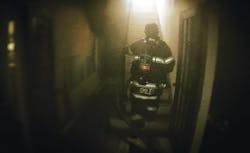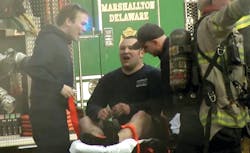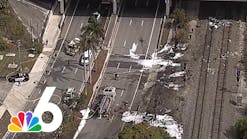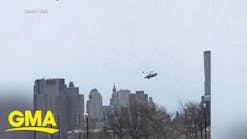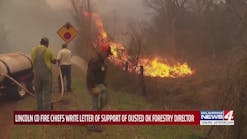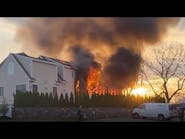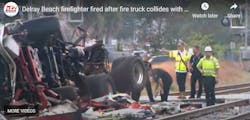On March 14, 2019, at 8:36 a.m., a house fire was dispatched in New Castle County, DE. The single-family dwelling was built in 1910 and had approximately 2,100 square feet of living space on two floors as well as a large attic and a small basement. The exterior walls were masonry with wood joists and flooring. The interior walls were plaster and lath. Division 1 consisted of four main rooms, two on either side of a main hallway and stairwell. Division 2 had four bedrooms and a bathroom in the center of the front of the house. The stairs continued from the second floor up to the attic. The bedrooms were in each corner of that division.
This working house fire resulted in the serious injury of Capt. Dave Smiley, who shares his very personal account with us in this month’s Close Calls column. This was a life-changing event for him and for others. We all can learn from his experiences.
Thanks to all of the agencies that responded or participated in any aspect of this incident, including the New Castle County Fireboard; New Castle County paramedics; Mill Creek Fire EMS; the fire companies of Aetna Hose, Hook & Ladder, Belvedere, Christiana, Cranston Heights, Elsmere, Five Points, Good Will, Hockessin, Mill Creek, Minquadale, Minquas, Talleyville, Wilmington and Wilmington Manor; and the Delaware State Fire School.
Account from Capt. Dave Smiley
The fire departments of New Castle County have pre-determined standard operating procedures (SOPs) that include arrival assignments in reference to fireground operations. Common terminology, such as first-due engine, first-due special service, second-due engine, etc., are used and recognized when assuming roles as units arrive on the fireground.
In reference to this incident, when assuming the second-due special service (rescue or truck/ladder company) per the SOP, the assignments to be completed are as follows: inside team—work with first-due special service, complete forcible entry and assist with completing the primary search (known rescue, immediate fire area out, floor above, top floor); outside team—work with first-due special service, ensure Charlie side is completed, horizontal/vertical ventilation as needed, ladder Alpha and Bravo sides of the building, secure utilities.
On March 14, Minquas Fire Company Rescue 23 had a three-firefighter outside team (two outside vent and operator) and a four-member inside team (an officer [Smiley], two barmen, who support crew/firefighters on the hoseline, and can firefighter with a water extinguisher).
The dispatched response for a residential structure fire includes four engine companies, two ladder companies and one rescue company. Because various units were on other runs and companies were understaffed, the initial assignment for this incident included three ladder companies (two with sufficient staffing), two rescue companies and three engine companies on the immediate response.
At 8:38 a.m., Rescue 23 was on the first alarm for the report of a house on fire on Mill Creek Road in the area of the Mill Creek Greenway Trail (in Mill Creek Fire Company 2’s coverage first-due area). The original report from a citizen reported fire from the roof.At this time, I was the rescue captain, and the Rescue responded with a crew of seven. New Castle County Fireboard (county 9-1-1 dispatch center) received and gave multiple updates as units were turned out, including changes of location and multiple calls that were received reporting fire from the house.
At approximately 8:42 a.m., Ambulance B2 of the Mill Creek Fire Company arrived, initially reporting smoke showing in the area, then reporting a fire in the rear of the residence, with unknown occupancy. Engine 21-6 then arrived, assuming the first-due engine company assignment, reporting fire showing from Division 2 on the Charlie/Delta corner. They also verified the address of the fire to be 3200 Mill Creek Road. The engine crew placed a 1¾-inch hoseline in service and requested the second-due engine company to forward lay from the hydrant on Mill Creek Road in the area of Riblett Lane. The initial thought was that there were no hydrants in this area; therefore, Engine 21-6 was unaware of this hydrant until they passed it.
Shortly after the arrival of Engine 21-6, Ladder 21-7 (a quint) arrived understaffed and assumed no assignment. Ladder 16 of the Elsmere Fire Company arrived and assumed the first-due special service role, followed closely by Rescue 23 as the second-due special service. I advised my operator to position directly beside Ladder 16, which had pulled beyond the driveway of the residence, as ordered by command. I observed light gray smoke pushing from the roof on the Alpha side and dark gray smoke pushing from the Delta side on the second floor.
Upon exiting the Rescue, I was equipped with a Pro-Bar and a thermal-imaging camera that was built into my SCBA. I met my crew as they exited the rear of the rig, and we proceeded to the Alpha side door of the residence. As we arrived, I met command face-to-face, and he advised that he wanted ground ladders placed on the Charlie and Delta sides of the structure, which is opposite of the sides that our SOPs require the second-due special service to ladder. I relayed to the outside vent firefighters to ladder the sides that were requested by command, keeping my interior team with me at the front door. The interior team then went “on air,” and I proceeded to force the Alpha side door, which still was locked and secured (first-due engine company and the first-due special service entered through the Delta and Charlie sides).
We made our way up the interior stairs, which were located just beyond the entrance, and proceeded to the second floor, where the fire originally was located by the first-in crews in a bedroom. We didn’t have our own hoseline, being the rescue company. We met the crews of Engine 21-6 and Ladder 16 on the stairs in the second-floor hallway. As I passed the hoseline, I thought it still was dry, because it appeared limp on the stairs. I made my way past the hose team, because the nozzleman was having mask problems, and they were switching positions.
At this point, my thought was that the incident was a smoldering bedroom fire, due to the fact that I believed the hoseline was dry up until this point, and I wanted to complete a quick search of the room of origin before we proceeded to the floor above. Ladder 16’s barman was in the room adjacent to the room where the fire presented itself, and I figured we would have the second-floor primary completed rather quickly. As I made my way into the bedroom, there was a noticeable, rapid change in temperature; both windows failed prior to my entrance.
The mayday
At this point, I was fully into the room, at the Charlie/Delta corner of the house, searching what was left of the bed. I had moved a dresser, and after quickly viewing the bed, it was clear that there wasn’t anyone in the room. My interior team was making their way down the hallway to join me, and Ladder 16’s officer was yelling to tell me that the engine crew was out of water.
This is the moment when I knew it was time to get out, and I proceeded to make my way back toward the entrance to the room, but I stopped to open a section of the wall where fire was presenting itself. As I stuck the end of my Pro-Bar tool into the wall, I sunk into the floor up to my knees. As I attempted to push myself back up, more of the floor gave way, and I now was into the floor up to my shoulders.
I began to scream for the crews that I knew where feet away from me. When I fell, my back became exposed, and my mask started to become dislodged as it hit the floorboards. Four members (two from Ladder 16, two from Rescue 23) immediately responded to my first call for help. The barman of Rescue 23 initially transmitted a mayday; the officer of Ladder 16 followed that with his own.
The mayday calls included location and a need for water, but they weren’t given fully and weren’t acknowledged immediately.
The first few attempts to free me were made by pulling on the shoulder straps on my SCBA. They weren’t successful, because my waist strap wasn’t secured, and I was twisted in the floor in such a manner that I couldn’t just be pulled out at an angle. It needed to be straight upward.
At this time, in my mind, it was do or die.
‘Let me go!’
I screamed for the others to let me go, but they instinctively wouldn’t release me. I fought against them until they lost their grip, and I pushed myself downward into the first floor. My body was positioned just below the second floor, stuck in the void between the floor below.
I removed my gloves, coat and airpack, as my hands were stuck above my head, tangled in the void. I dropped to the first floor completely, only held up by my facepiece, which still was connected to my regulator. I observed minimal fire conditions on the first floor, removed my facepiece, and made a run back through the house and out of the front door. The mayday was then cleared. I removed the remainder of my gear in the front yard and walked to the awaiting stretcher.15 days in the burn unit
I immediately was loaded into the back of a BLS ambulance, and New Castle County paramedics arrived and began providing care. The BLS unit, with the ALS providers on board, transported me to the hospital, where I was intubated. I was transferred to a burn-treatment center. I was intubated for approximately eight hours and spent 15 days in the burn unit.
The stay included two surgeries, skin grafts, breathing treatments, physical and mental therapy and multiple visits from investigators. Thankfully, I also received a ton of support in person and via social media from many people to whom I am forever grateful.
After being released from the hospital, I attended frequent outpatient appointments and physical therapy daily for about three months. I then attended physical therapy weekly for another four months before being cleared to return to work for full duty and firefighting.
Lessons learned
It’s been a year since the incident, which has given me time to critique myself thoroughly, to address the errors that I made and to quash some claims that didn’t pertain to myself or to my crew.
The first mistake that I made—not only at the Mill Creek Road fire but fires before—was utter complacency. I wore a helmet that had no chin strap and virtually no protective features. I didn’t fasten the waist strap on my SCBA—for no other reason than this is the way that I always did it. The gloves that I had on were structural firefighting gloves that I was using as a demo for a vendor.
After the mayday, there were multiple requests for crews to evacuate the building, which went completely unfollowed and disregarded by the crews that remained inside (Rescue 23 wasn’t part of this).
This fire, which presented itself as a second-floor bedroom fire, originated in the first-floor laundry room below the bedroom. This burned unnoticed for quite some time, even while crews entered around it and operated above it. There initially was confusion as to which side of the building was to be considered the Charlie side, and the first-due special service’s outside vent firefighter gave a Charlie-side report from the Bravo side of the building. Therefore, the smoke and fire that was visible from a window on the first floor never was reported and was missed by multiple crews who operated on the second floor at the time of the mayday.
I have learned and matured. For the longest time, I blamed everybody for what happened here except for myself. I won’t place the entire blame on myself, but I will place part of it on me. In blaming others, I lost a lot of friendships that I cherished and said a lot of things that I can’t take back, and for that I apologize. I also will say that I gained many friendships through learning from the most difficult day of my life. The brotherhood always prevails, and I hope the readers of this article gain something from my experience. Never stop learning, never stop training and keep pushing forward.
Comments from Chief Goldfeder
If you aren’t moved by Capt. Smiley’s sharing of this story, then something is wrong, and you need to re-read this column. Our sincere thanks to Smiley for being honest and forthright, so others may learn. Smiley covered the most critical points, so I will highlight only a few that are directly and indirectly related to this incident and that can be compared to or applied to your own departments.
The rules, policies and, in many areas, the law are clear: Follow command’s orders. It isn’t a vote, a discussion or something that you can do when you’re ready. When command orders anything, just do it, in coordination with your crew. When command orders an evacuation, act as if they probably know more than you do. Get out.
To be clear: Doing what you want to do on the fireground is as bad as it can get—and you’re putting yourself and your so-called brother and sister firefighters at grave risk. The fireground isn’t your playground, and command must not tolerate anything other than orders being followed.
So many departments are running understaffed. Although there were some understaffed companies due on this fire, you’ll notice that their first alarm consists of numerous departments giving them—and the people having the fire—a fighting chance. Remember, a fire for us is like an arm wrestle where we start being pinned and we must raise and nail the opponent to the opposite side. If your department still operates in a bubble in which you have known and documented staffing issues and don’t have a cooperative, automatic mutual-aid (fair and equal) response that assures 20–30 firefighters on the first alarm, it’s time to rethink your operations. Career, volunteer, whatever. Staffing is the one thing that is unequivocally required when responding. If you can’t get staffing the way that you would like (because of economics, politics, egos, false pride, poor turnout, failed leadership, tradition or whatever), then it’s time to plan, before you suffer an irreversible loss. Fortunately, the departments of New Castle County operate as a pseudo-county-wide system that has pre-planned “box alarm” type responses, which is what is best for the public and for the firefighters who respond.
The best way that departments can assure strong command, control, accountability and communication is by policy, procedure and drilling regularly. If you respond regularly on fires with neighboring departments or companies, regular drills aren’t optional.
Incidents in which a helmet chin strap wasn’t buckled and a firefighter lost their helmet and suffered significant injuries have come up before. You also will note the SCBA strap comment from Smiley. Chin, SCBA and anything that has a strap: use it. Officers: Set the example by doing it and enforcing it.
If you want to or are asked to “field test” something, make sure that the department that’s participating in the test approves. And a note to vendors: Understand the potential risk that you’re taking without a “formal” field testing system—everything in writing—in cooperation with your department.
The Delaware State Fire School was asked to and conducted an evaluation of this incident. Their report is available at https://statefireschool.delaware.gov/wp-content/uploads/sites/114/2019/08/Mill-Creek-Incident-Review-Report-2019.pdf.
In conclusion, read this piece again, share this piece and pay close attention to Smiley’s personal comments and his recommendations to each of us. Simply put, he doesn’t want you to experience what he did, and for that, we all are grateful.
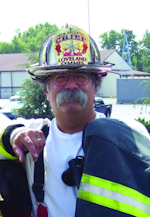
Billy Goldfeder
BILLY GOLDFEDER, EFO, who is a Firehouse contributing editor, has been a firefighter since 1973 and a chief officer since 1982. He is deputy fire chief of the Loveland-Symmes Fire Department in Ohio, which is an ISO Class 1, CPSE and CAAS-accredited department. Goldfeder has served on numerous NFPA and International Association of Fire Chiefs (IAFC) committees. He is on the board of directors of the IAFC Safety, Health and Survival Section and the National Fallen Firefighters Foundation.
